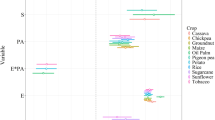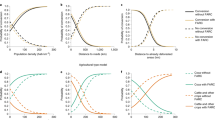Abstract
Competition for land is increasing as a consequence of the growing demands for food and other commodities and the need to conserve biodiversity and ecosystem services. Land conversion and the intensification of current agricultural systems continues to lead to a loss of biodiversity and trade-offs among ecosystem functions. Decision-makers need to understand these trade-offs in order to better balance different demands on land and resources. There is an urgent need for spatially explicit information and analyses on the effects of different trajectories of human-induced landscape change in biodiversity and ecosystem services. We assess the potential implications of a set of plausible socio-economic and climate scenarios for agricultural production and demand and model-associated land use and land cover changes between 2005 and 2050 to assess potential impacts on biodiversity in Uganda, Rwanda and Burundi. We show that different future socio-economic scenarios are consistent in their projections of areas of high agricultural development leading to similar spatial patterns of habitat and biodiversity loss. Yet, we also show that without protected areas, biodiversity losses are higher and that expanding protected areas to include other important biodiversity areas can help reduce biodiversity losses in all three countries. These results highlight the need for effective protection and the potential benefits of expanding the protected area network while meeting agricultural production needs.






Similar content being viewed by others
Notes
IPSL-CM5A-LR—The Institut Pierre Simon Laplace’s Earth System Model.
References
African Development Bank (2014) Country profiles. http://dataportal.afdb.org/default.aspx. Accessed 2 Dec 2014
African Development Bank, OECD, UNDP (2014a) African economic outlook 2014: Regional Edition—East Africa
Aiking H (2011) Future protein supply. Trends Food Sci Tech 22(2):112–120. doi:10.1016/j.tifs.2010.04.005
Alcamo J, Schaldach R, Koch J, Lapola DM, Priess JA (2011) Evaluation of an integrated land use change model including a scenario analysis of land use change for continental Africa. Environ Model Softw 26(8):1017–1027. doi:10.1016/j.envsoft.2011.03.002
Alexandratos N (2009) World food and agriculture to 2030/50: highlights and views from mid-2009. In: How to feed the World in 2050. Proceedings of a technical meeting of experts, Rome, Italy, 24–26 June 2009, pp 1–32. Food and Agriculture Organization of the United Nations (FAO)
Andam KS, Ferraro PJ, Pfaff A, Sanchez-Azofeifa GA, Robalino JA (2008) Measuring the effectiveness of protected area networks in reducing deforestation. Proc Natl Acad Sci 105(42):16089–16094. doi:10.1073/pnas.0800437105
Andren H (1994) Effects of habitat fragmentation on birds and mammals in landscapes with different proportions of suitable habitat: a review. Oikos. doi:10.2307/3545823
Bartholomé E, Belward AS (2005) GLC2000: a new approach to global land cover mapping from Earth observation data. Int J Remote Sens 26:1959–1977. doi:10.1080/01431160412331291297
Biggs R, Simons H, Bakkenes M, Scholes RJ, Eickhout B, van Vuuren D, Alkemade R (2008) Scenarios of biodiversity loss in southern Africa in the 21st century. Glob Environ Change 18(2):296–309. doi:10.1016/j.gloenvcha.2008.02.001
BirdLife International (2012) Conservation strategy for the Great Lakes Region of East and Central Africa. http://www.birdlife.org/sites/default/files/attachments/AUTHORISED-GLR-STRATEGY_0.pdf. Accessed 3 April 2016
Birdlife International (2013) World bird and biodiversity areas database
Bondeau A, Smith P, Zaehle S, Schaphoff S, Lucht W, Cramer W, Gerten D, Lotze-Campen H, Müller C, Reichstein M, Smith B (2007) Modelling the role of agriculture for the 20th century global terrestrial carbon balance. Global Change Biol 13:679–706. doi:10.1111/j.1365-2486.2006.01305.x
Buchanan GM, Donald PF, Butchart SHM (2011) Identifying priority areas for conservation: a global assessment for forest-dependent birds. PLoS ONE 6:e29080. doi:10.1371/journal.pone.0029080
Center for International Earth Science Information Network (CIESIN), Columbia University, International Food Policy Research Institute (IFPRI),the World Bank, Centro Internacional de Agricultura Tropical (CIAT) (2011) Global rural-urban mapping project, Version 1 (GRUMPv1): Population density grid. Palisades, NY: Socioeconomic Data and Applications Center (SEDAC), Columbia University. doi: 10.7927/H4R20Z93
Center for International Earth Science Information Network (CIESIN)/Columbia University, Information Technology Outreach Services (ITOS)/University of Georgia (2013) Global roads open access data set, Version 1 (gROADSv1). Palisades, NY: NASA Socioeconomic Data and Applications Center (SEDAC). doi: 10.7927/H4VD6WCT
CEPF (2012) Ecosystem profile: eastern afromontane biodiversity hotspot. http://www.cepf.net/Documents/Eastern_Afromontane_Ecosystem_Profile_Final.pdf. Accessed 12 Dec 2014
Corbera E, Schroeder H (2011) Governing and implementing REDD+. Environ Sci Policy 14(2):89–99. doi:10.1016/j.envsci.2010.11.002
Delzeit R, Zabel F, Meyer C, Václavík T (2016) Addressing future trade-offs between biodiversity and cropland expansion to improve food security. Reg Environ Change. doi:10.1007/s10113-016-0927-1
Dufresne JL, Foujols MA, Denvil S, Caubel A, Marti O, Aumont O, Balkanski Y, Bekki S, Bellenger H, Benshila R, Bony S (2013) Climate change projections using the IPSL-CM5 earth system model: from CMIP3 to CMIP5. Clim Dyn 40(9-10):2123–2165. doi:10.1007/s00382-012-1636-1
FAO (2014) Food and agricultural organization -statistic division. http://faostat.fao.org/site/291/default.aspx. Accessed 12 Dec 2014
Foden WB, Butchart SH, Stuart SN, Vié JC, Akçakaya HR, Angulo A, DeVantier LM, Gutsche A, Turak E, Cao L, Donner SD (2013) Identifying the world’s most climate change vulnerable species: a systematic trait-based assessment of all birds, amphibians and corals. PLoS ONE 8(6):e65427. doi:10.1371/journal.pone.0065427
Foley JA, DeFries R, Asner GP, Barford C, Bonan G, Carpenter SR, Chapin FS, Coe MT, Daily GC, Gibbs HK, Helkowski JH (2005) Global consequences of land use. Science 309(5734):570–574. doi:10.1126/science.1111772
Foley JA, Ramankutty N, Brauman KA, Cassidy ES, Gerber JS, Johnston M, Mueller ND, O’Connell C, Ray DK, West PC, Balzer C, Bennett EM, Carpenter SR, Hill J, Monfreda C, Polasky S, Rockström J, Sheehan J, Siebert S, Tilman D, Zaks DPM (2011) Solutions for a cultivated planet. Nature 478:337–342. doi:10.1038/nature10452
Fritz S, See L, McCallum I, Schil C, Obersteiner M, Van der Velde M, Boettcher H, Havlík P, Achard F (2011) Highlighting continued uncertainty in global land cover maps for the user community. Environ Res Lett 6(4):044005. doi:10.1088/1748-9326/6/4/044005
Godfray HCJ, Beddington JR, Crute IR, Haddad L, Lawrence D, Muir JF, Pretty J, Robinson S, Thomas SM, Toulmin C (2010) Food security: the challenge of feeding 9 billion people. Science 327(5967):812–818. doi:10.1126/science.1185383
Guillaume DM, Stasavage D (2000) Improving policy credibility: is there a case for African monetary unions? World Dev 28:1391–1407. doi:10.1016/s0305-750x(00)00038-3
Herold M, Mayaux P, Woodcock CE, Baccini A, Schmullius C (2008) Some challenges in global land cover mapping: an assessment of agreement and accuracy in existing 1 km datasets. Remote Sens Environ 112:2538–2556. doi:10.1016/j.rse.2007.11.013
Heubes J, Schmidt M, Stuch B, Márquez JRG, Wittig R, Zizka G, Thiombiano A, Sinsin B, Schaldach R, Hahn K (2013) The projected impact of climate and land use change on plant diversity: an example from West Africa. J Arid Environ 96:48–54. doi:10.1016/j.jaridenv.2013.04.008
IUCN, 2013. The IUCN Red list of threatened species. Version 2013.1. http://www.iucnredlist.org. Accessed 1 July 2013
IUCN and UNEP-WCMC (2014) The world database on protected areas (WDPA), August 2014. UNEP-WCMC, Cambridge
Jarvis A, Reuter HI, Nelson A, Guevara E (2008) Hole-filled SRTM for the globe Version 4, available from the CGIAR-CSI SRTM 90 m Database
Mandemaker M, Bakker M, Stoorvogel J (2011) The role of governance in agricultural expansion and intensification: a global study of arable agriculture. Ecol Soc 16:8. doi:10.5751/es-04142-160208
Mapendembe A, Sassen M (2014) Commodities and biodiversity in the Great Lakes of East Central Africa Region. Impacts of commodity development on biodiversity and ecosystem services. Technical Report, UNEP-WCMC, Cambridge
O’Neill BC, Kriegler E, Riahi K, Ebi KL, Hallegatte S, Carter TR, Mathur R, van Vuuren DP (2014) A new scenario framework for climate change research: the concept of shared socioeconomic pathways. Clim Change 122(3):387–400. doi:10.1007/s10584-013-0905-2
Prett J, Toulmin C, Williams S (2011) Sustainable intensification in African agriculture. Int J Agric Sustain 9(1):5–24. doi:10.3763/ijas.2010.0583
Purvis A, Gittleman JL, Cowlishaw G, Mace GM (2000) Predicting extinction risk in declining species. Proc R Soc London Ser B 267(1456):1947–1952. doi:10.1098/rspb.2000.1234
Riahi K, Rao S, Krey V, Cho C, Chirkov V, Fischer G, Kindermann G, Nakicenovic N, Rafaj P (2011) RCP 8.5—a scenario of comparatively high greenhouse gas emissions. Clim Change 109:33–57. doi:10.1007/s10584-011-0149-y
Rosegrant MW, Msangi S, Ringler C, Sulser TB, Zhu T, Cline SA (2008) International model for policy analysis of agricultural commodities and trade (IMPACT): Model description. International Food Policy Research Institute, Washington
Schaldach R, Alcamo J, Koch J, Kölking C, Lapola DM, Schüngel J, Pries J (2011) An integrated approach to modelling land-use change on continental and global scales. Environ Modell Softw 26(8):1041–1051. doi:10.1016/j.envsoft.2011.02.013
Seimon A, Plumptre A (2012) Albertine rift, Africa. In: Hilty JA, Chester CC, Cross MS (eds) Climate and conservation: landscape and seascape science, planning, and action. Island Press/Center for Resource Economics, Washington, DC, pp 33–44
Seppelt R, Lautenbach S, Volk M (2013) Identifying trade-offs between ecosystem services, land use, and biodiversity: a plea for combining scenario analysis and optimization on different spatial scales. Curr Opin Env Sust 5:458–463. doi:10.1016/j.cosust.2013.05.002
Vervoort JM, Palazzo A, Mason-D’Croz D, Ericksen PJ, Thornton PK, Kristjanson P, Förch W, Herrero M, Havlik P, Jost C, Rowlands H (2013) The future of food security, environments and livelihoods in Eastern Africa: four socio-economic scenarios. CCAFS Working Paper no. 63. CGIAR Research Program on Climate Change, Agriculture and Food Security (CCAFS). Copenhagen, Denmark
Watson SJ, Luck GW, Spooner PG, Watson DM (2013) Land-use change: incorporating the frequency, sequence, time span, and magnitude of changes into ecological research. Front Ecol Environ 12(4):241–249. doi:10.1890/130097
World Bank (2014) World Bank Databank
Acknowledgments
We would like to thank all participants of the scenario development process for their active contributions. This work was funded through a Grant from the MacArthur Foundation with funding for scenario development provided by CGIAR Research Program on Climate Change, Agriculture, and Food Security (CCAFS).
Author information
Authors and Affiliations
Corresponding author
Electronic supplementary material
Below is the link to the electronic supplementary material.
Rights and permissions
About this article
Cite this article
van Soesbergen, A., Arnell, A.P., Sassen, M. et al. Exploring future agricultural development and biodiversity in Uganda, Rwanda and Burundi: a spatially explicit scenario-based assessment. Reg Environ Change 17, 1409–1420 (2017). https://doi.org/10.1007/s10113-016-0983-6
Received:
Accepted:
Published:
Issue Date:
DOI: https://doi.org/10.1007/s10113-016-0983-6




